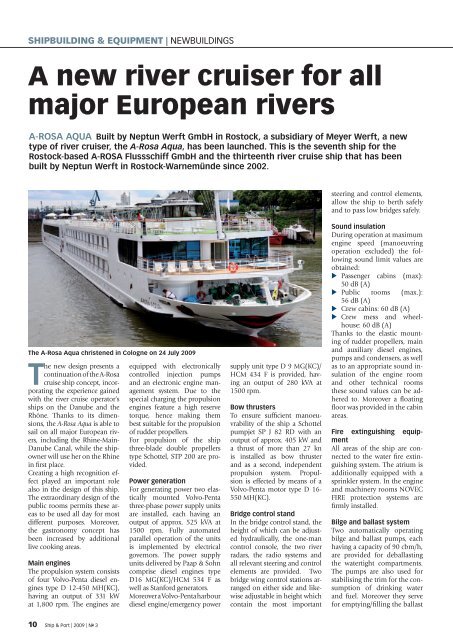Create successful ePaper yourself
Turn your PDF publications into a flip-book with our unique Google optimized e-Paper software.
SHIPBUILDING & EQUIPMENT | NEWBUILDINGS<br />
A new river cruiser for all<br />
major European rivers<br />
A-ROSA AQUA Built by Neptun Werft GmbH in Rostock, a subsidiary of Meyer Werft, a new<br />
type of river cruiser, the A-Rosa Aqua, has been launched. This is the seventh ship for the<br />
Rostock-based A-ROSA Flussschiff GmbH and the thirteenth river cruise ship that has been<br />
built by Neptun Werft in Rostock-Warnemünde since 2002.<br />
steering and control elements,<br />
allow the ship to berth safely<br />
and to pass low bridges safely.<br />
The A-Rosa Aqua christened in Cologne on 24 July 2009<br />
The new design presents a<br />
continuation of the A-Rosa<br />
cruise ship concept, incorporating<br />
the experience gained<br />
with the river cruise operator‘s<br />
ships on the Danube and the<br />
Rhône. Thanks to its dimensions,<br />
the A-Rosa Aqua is able to<br />
sail on all major European rivers,<br />
including the Rhine-Main-<br />
Danube Canal, while the shipowner<br />
will use her on the Rhine<br />
in first place.<br />
Creating a high recognition effect<br />
played an important role<br />
also in the design of this ship.<br />
The extraordinary design of the<br />
public rooms permits these areas<br />
to be used all day for most<br />
different purposes. Moreover,<br />
the gastronomy concept has<br />
been increased by additional<br />
live cooking areas.<br />
Main engines<br />
The propulsion system consists<br />
of four Volvo-Penta diesel engines<br />
type D 12-450 MH(KC),<br />
having an output of 331 kW<br />
at 1,800 rpm. The engines are<br />
equipped with electronically<br />
controlled injection pumps<br />
and an electronic engine management<br />
system. Due to the<br />
special charging the propulsion<br />
engines feature a high reserve<br />
torque, hence making them<br />
best suitable for the propulsion<br />
of rudder propellers.<br />
For propulsion of the ship<br />
three-blade double propellers<br />
type Schottel, STP 200 are provided.<br />
Power generation<br />
For generating power two elastically<br />
mounted Volvo-Penta<br />
three-phase power supply units<br />
are installed, each having an<br />
output of approx. 525 kVA at<br />
1500 rpm. Fully automated<br />
parallel operation of the units<br />
is implemented by electrical<br />
governors. The power supply<br />
units delivered by Paap & Sohn<br />
comprise diesel engines type<br />
D16 MG(KC)/HCM 534 F as<br />
well as Stanford generators.<br />
Moreover a Volvo-Penta harbour<br />
diesel engine/emergency power<br />
supply unit type D 9 MG(KC)/<br />
HCM 434 F is provided, having<br />
an output of 280 kVA at<br />
1500 rpm.<br />
Bow thrusters<br />
To ensure sufficient manoeuvrability<br />
of the ship a Schottel<br />
pumpjet SP J 82 RD with an<br />
output of approx. 405 kW and<br />
a thrust of more than 27 kn<br />
is installed as bow thruster<br />
and as a second, independent<br />
propulsion system. Propulsion<br />
is effected by means of a<br />
Volvo-Penta motor type D 16-<br />
550 MH(KC).<br />
Bridge control stand<br />
In the bridge control stand, the<br />
height of which can be adjusted<br />
hydraulically, the one-man<br />
control console, the two river<br />
radars, the radio systems and<br />
all relevant steering and control<br />
elements are provided. Two<br />
bridge wing control stations arranged<br />
on either side and likewise<br />
adjustable in height which<br />
contain the most important<br />
Sound insulation<br />
During operation at maximum<br />
engine speed (manoeuvring<br />
operation excluded) the following<br />
sound limit values are<br />
obtained:<br />
Passenger cabins (max):<br />
50 dB (A)<br />
Public rooms (max.):<br />
56 dB (A)<br />
Crew cabins: 60 dB (A)<br />
Crew mess and wheelhouse:<br />
60 dB (A)<br />
Thanks to the elastic mounting<br />
of rudder propellers, main<br />
and auxiliary diesel engines,<br />
pumps and condensers, as well<br />
as to an appropriate sound insulation<br />
of the engine room<br />
and other technical rooms<br />
these sound values can be adhered<br />
to. Moreover a floating<br />
floor was provided in the cabin<br />
areas.<br />
Fire extinguishing equipment<br />
All areas of the ship are connected<br />
to the water fire extinguishing<br />
system. The atrium is<br />
additionally equipped with a<br />
sprinkler system. In the engine<br />
and machinery rooms NOVEC<br />
FIRE protection systems are<br />
firmly installed.<br />
Bilge and ballast system<br />
Two automatically operating<br />
bilge and ballast pumps, each<br />
having a capacity of 90 cbm/h,<br />
are provided for deballasting<br />
the watertight compartments.<br />
The pumps are also used for<br />
stabilising the trim for the consumption<br />
of drinking water<br />
and fuel. Moreover they serve<br />
for emptying/filling the ballast<br />
10 Ship & Port | 2009 | N o 3
















